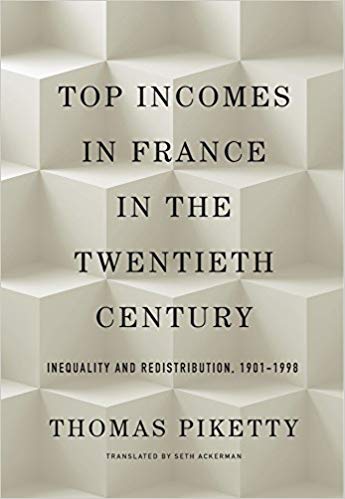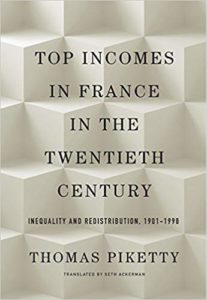
Top Incomes in France in the Twentieth Century Inequality and Redistribution, 1901–1998 by Thomas Piketty

This book is a tribute to the stature of Thomas Piketty. It is somewhat dated in that it is a translation of Piketty’s 2001 book with data through 1998. Further, it is long—over 500 pages of text and another 700 pages of appendices and footnotes. Piketty goes into great detail about many small issues around a simple, broad theme: that inequality in twentieth century France declined from 1900 to 1983 (because of lower incomes of those at the very top of the income ladder), before rising slightly from 1984 to 1998. Piketty is interested in the long sweep of history and laments that French income tax data started in 1900 because he thinks that what happened in the nineteenth century is important to understanding the evolution of inequality in a capitalist economy. While he admires Kuznets meticulous studies on income distributions in the US, he argues forcibly that the “Kuznets’ Inverted U-Curve” is incorrect in predicting lower income inequality in the later phases of capitalism.
Shortly after releasing this book, Piketty and Emmanuel Saez used the same methodology to track changing incomes in the US. Their 2003 article greatly affected how inequality in the US has been discussed because of two big findings: first they showed that the share of income going to the top 1 percent had grown significantly; and second, the real incomes of the bottom 90 percent had stagnated. As they updated their data each year through 2015, they continued to report income growth going to the rich and stagnating middle class incomes. Several researchers using a variety of data sources challenged the finding that middle incomes in America didn’t rise over time and identified many of the problematic elements of the Piketty and Saez approach. Eventually, Zucman joined the Piketty-Saez team in developing a whole new approach.
While Piketty and Saez maintain that the two approaches are consistent, Rose showed that the new approach had very different results from their old approach.[1] First, real median income from 1979 to 1984 grew by 33 percent in the new approach and declined by 8 percent with the original methodology. Second, the share of growth going to the top 10 percent was 55 percent in the new approach and 100 percent in the old approach. When pressed by Robert Samuelson of the Washington Post about this discrepancy, Saez said that the numbers of the new methodology were their best estimates.[2]
The commitment of Piketty to the new methodology is reflected in the creation of the World Inequality Report. Piketty and a team of 125 collaborators have applied the new approach to the histories of income distributions in many countries from 1900 to 2015.[3] Although this means that the data tables in the current book are no longer applicable, there are other reasons to read the book. His periodization of twentieth century inequality is very interesting. First, the two world wars and depression were disastrous for the very rich. Second, from 1945 to 1968, there was “a phase of very rapidly reemerging income inequality “(157). Third, the years from 1968 to 1983 were characterized by “very sharp income compression” followed by 15 years (1983 to 1998) with increasing inequality.
Connected with income inequality, Piketty addresses wage inequality in France over these years (incomes are the total of all cash received by all members of a family while earnings are yearly payments for work and wages reflecting the hourly rate of pay). This starts with the very definition of occupations. Originally, occupations were aggregated into a few categories—ouvriers (blue-collar workers), employés (non-blue-collar workers), chefs d’établissement (proprietors), and travailleurs isolés (isolated workers). A new occupational system was not adopted until 1982, with special categories created to reflect more college-educated professionals. These categories were used in the administrative forms that employers had to fill out with their wage declarations that began in 1917. In contrast, most US studies on workers’ earnings and occupations began in 1940 and are based on large surveys with up to 500 detailed occupations.
In France the share of top 10 percent of earnings has always been lower than the income share of the top 10, and it has varied narrowly between 25 and 28 percent from 1947 to 1998. The top 1 percent share was 8 percent in the 1960s before declining to under 6 percent after 1983. The ratio of cadres supérieurs to ouvriers was steady at about 4.4 from 1951 to 1969 before it too declined to 2.6 from 1993 to 1998.
The difference between the movements of income and earnings inequality can be traced to the movements of capital income which is part of income but not part of earnings. But the experiences of French workers as presented here are very different from that of American workers. In the US, there was a large “wage compression” from 1940 through 1970, followed by rising inequality closely associated with levels of education[4]. Consequently, Piketty’s data on wage inequality after 1970 differs significantly from the US experience since he never presents earnings by educational levels
Another interesting section is the discussion of the change in tax laws in Chapter 4 where he connects the continued resetting of income brackets and rates to the politics of the time. Prior to the 1914 income tax adoption (not implemented until the following year), the French government relied on the “four old ladies” of direct taxation adopted in 1792: a “doors and windows” tax on housing, a real estate tax on houses, buildings and open land, a business license tax, and a personal property tax. In the 50 years before the establishment of an income tax, there were two tax laws passed aimed at increasing taxes for the wealthy: in 1872, a new tax on investment and securities income was created, which was followed by changing the inheritance tax in 1901 from being proportional to being progressive. Piketty then spends the next 200 pages discussing the adoption of the income tax and the changing of the many rates on the various types of income and how it impacted different rungs of the income ladder. It is not by accident that the subtitle of the book highlights the redistribution of income.
There are two interesting elements of this long discussion. On the one hand, there is the continuing conflict between left and right factions over how much to tax the rich. While the highest marginal rate when the income tax started was 20 percent, it reached 62 percent at the end of World War I. After 1920, the rates bounced around from 24 to 72 percent depending on the state of the economy and the needs of the state (Table 4.2, 258). In the years before WWII, the top rate was 40 percent and was raised to 70 percent from 1942 to 1944 (Table 4.5, 291-297). In the years after the war, there was much more consistency with the top rate staying at 60 percent from 1946 through 1981. It rose to 65 percent from 1982 to 1985 before falling to 56.8 percent through 1995. Finally, in the last years covered by the book, the top rate was reduced to 54 percent.
The more astonishing feature of the French tax regime is how few people pay income taxes (Table 5.1, 344). It was only after the end of WWII that more than 20 percent of the population paid income taxes. This share increased steadily to reach 65 percent in 1980. But in one fell swoop in 1986, the share dropped to 52 percent. In the years after 1986, about 50 percent of the population paid income taxes (the comparable figure was over 90 percent in the U.S.).
Piketty concludes by predicting that the years following 1998 will be “boom times wealth owners. But it is difficult to say how long this economic and intellectual conjuncture will last… [because} societies that are too obviously unequal are inherently unstable” (521). Obviously the first part of this statement has proven to be true while the second part hasn’t. In conclusion, Piketty’s work after this book has documented the large rise in inequality in the US and other countries. The estimates on the level of inequality in the US have been trimmed with his new approach, but his work has had a major impact on the narrative that inequality is too high in many countries. The importance of Piketty’s early research on inequality in France was a stepping stone to creating a world compendium of inequality statistics for all major and most minor countries in the world.
Reviewed by Stephen Rose, The Income and Benefits Policy Center at the Urban Institute
Top Incomes in France in the Twentieth Century Inequality and Redistribution, 1901–1998
By Thomas Piketty
Publisher: Harvard Press
Hardcover / 1280 pages / 2018
ISBN 9780674737693
To read more book reviews click here
Published on February 5, 2019.
References:
[1] Rose, Stephen J. 2018.”How Different Studies Measure Income Inequality: Piketty and Company Are Not the Only Game in Town.” Washington, D.C.: Urban Institute.
[2]Samuelson, Robert. “We’ve become addicted to the income stagnation story. It’s probably not true.” Washington Post. December 9, 2018.
[3] Available at https://wid.world.
[4]Goldin, Claudia and Robert Margo. 1991. “The Great Compression: The Wage Structure in the United States at Mid-Century.” National Bureau for Economic Research, Working Paper #3817.




